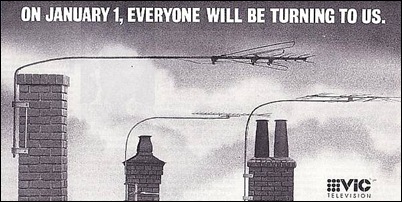 It is twenty years since the final stages of the aggregation of regional markets were launched in the eastern states – finally bringing viewers in those areas the same amount of choice of commercial television as their capital city cousins.
It is twenty years since the final stages of the aggregation of regional markets were launched in the eastern states – finally bringing viewers in those areas the same amount of choice of commercial television as their capital city cousins.
Following implementation in Southern NSW and Canberra (1989) and Regional Queensland (1990) came the aggregation of Northern NSW markets (Newcastle/Hunter Valley, Tamworth/Upper Namoi and Taree, and Coffs Harbour and Lismore/Gold Coast) starting from 31 December 1991.
 The change saw NBN Television (NBN3 Newcastle) align to the Nine Network for program supply, Prime (NEN9 Tamworth, ECN8 Taree) to the Seven Network, and NRTV (NRN11 Coffs Harbour, RTN8 Lismore) to the Ten Network, as they expanded their coverage into each others’ markets.
The change saw NBN Television (NBN3 Newcastle) align to the Nine Network for program supply, Prime (NEN9 Tamworth, ECN8 Taree) to the Seven Network, and NRTV (NRN11 Coffs Harbour, RTN8 Lismore) to the Ten Network, as they expanded their coverage into each others’ markets.
Prime had a delayed launch in the Coffs Harbour and Lismore/Gold Coast markets – scheduled for completion by May 1992 – while NRTV (now Southern Cross Ten) had delayed its expansion into the Tamworth/Upper Namoi and Taree regions until late January.
 And from 1 January 1992 came the first stage in the aggregation of regional Victorian markets Ballarat, Bendigo/Central Victoria, Shepparton/Goulburn Valley, Albury/Upper Murray and Gippsland – with VIC TV (BTV6 Ballarat, GMV6 Shepparton) and Southern Cross Network (BCV8 Bendigo, GLV8 Gippsland) launching their signals in competition across the expanded market. Aggregation was initially scheduled for 1993 for Regional Victoria but had been brought forward a year.
And from 1 January 1992 came the first stage in the aggregation of regional Victorian markets Ballarat, Bendigo/Central Victoria, Shepparton/Goulburn Valley, Albury/Upper Murray and Gippsland – with VIC TV (BTV6 Ballarat, GMV6 Shepparton) and Southern Cross Network (BCV8 Bendigo, GLV8 Gippsland) launching their signals in competition across the expanded market. Aggregation was initially scheduled for 1993 for Regional Victoria but had been brought forward a year.
VIC TV (now a part of the WIN network) was affiliated to Nine for programming, and Southern Cross Network (now Southern Cross Ten) linked to the Ten Network.

Albury-based Prime (AMV) had a delayed expansion across the remainder of the regional Victorian market, commencing transmission in its new regions by March 1992. Like its NSW counterparts, Prime was affiliated to the Seven Network.
 The delayed implementation of Prime across regional Victoria effectively denied viewers outside of Albury any access to Seven Network programs for two months. With Seven having telecast rights to major sporting events the Australian Open tennis and the Australian Masters golf over those two months, Southern Cross came to a special arrangement to broadcast those events across the aggregated market despite them being a Ten Network affiliate – but Prime ensured it was up and running across Victoria in time to cover the AFL season!
The delayed implementation of Prime across regional Victoria effectively denied viewers outside of Albury any access to Seven Network programs for two months. With Seven having telecast rights to major sporting events the Australian Open tennis and the Australian Masters golf over those two months, Southern Cross came to a special arrangement to broadcast those events across the aggregated market despite them being a Ten Network affiliate – but Prime ensured it was up and running across Victoria in time to cover the AFL season!
Mildura, in north west Victoria, was excluded from the aggregation scheme, with its local channel STV8 part of the VIC TV network, therefore gaining access predominantly to Nine Network programming only. Some exceptions were made for major sporting events and other special telecasts from the Seven and Ten networks to be broadcast into Mildura via VIC TV.
 With aggregation then completed in the major regional markets of New South Wales (including ACT), Queensland and Victoria the next step was to consider options for additional choice of commercial television in other regional markets and smaller capital cities. Aggregation was then introduced into Tasmania in April 1994, with Hobart-based TAS TV (TVT6) and Launceston-based Southern Cross Network (TNT9) expanding into each others’ markets in competition with each other – while Darwin, Mildura and Regional Western Australia would each be assigned a second commercial licence in the late ‘90s.
With aggregation then completed in the major regional markets of New South Wales (including ACT), Queensland and Victoria the next step was to consider options for additional choice of commercial television in other regional markets and smaller capital cities. Aggregation was then introduced into Tasmania in April 1994, with Hobart-based TAS TV (TVT6) and Launceston-based Southern Cross Network (TNT9) expanding into each others’ markets in competition with each other – while Darwin, Mildura and Regional Western Australia would each be assigned a second commercial licence in the late ‘90s.
The satellite-based remote commercial television services of Imparja (primarily covering central Australia but also isolated regions of Victoria and NSW) and Ten Satellite (remote Queensland) were permitted to expand into each others’ coverage areas in competition from 1999 – with Imparja aligned to the Nine and Ten networks for programming, and Ten Satellite re-branded as Seven Central (now Southern Cross) for its new affiliation to the Seven Network.
It was to be the early 2000s before the regional South Australian markets of Mount Gambier, Riverland and Spencer Gulf (including Broken Hill) would get a choice of commercial TV channels with their existing monopoly broadcasters permitted to open a second channel.
The advent of digital television has since seen the launch of a third commercial signal in Tasmania, Darwin, Mildura, Regional Western Australia, regional South Australian markets and central Australia.
More on aggregation at Television.AU








